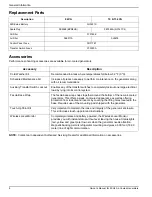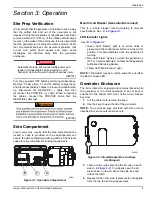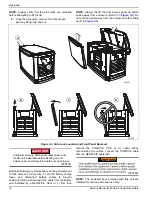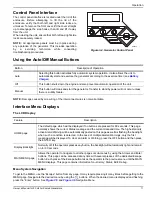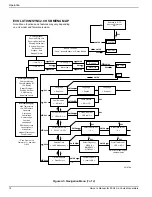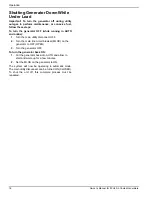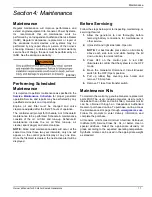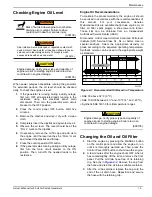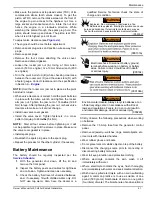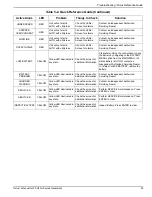
Maintenance
22
Owner’s Manual for 50 Hz Air-Cooled Generators
to be added until the evidence of reaction (foaming) has
ceased. The resulting liquid is to be flushed with water
and the area dried.
•
DO NOT smoke when near the battery.
•
DO NOT cause flame or spark in the battery area.
•
Discharge static electricity from the body before touching
the battery by first touching a grounded metal surface.
Attention After Submersion
If the generator has been submerged in water, it MUST
NOT be started and operated. Following any submersion
in water, have an Independent Authorized Service Dealer
thoroughly clean, dry, and inspect the generator. If the
structure (home) has been flooded, it should be
inspected by a certified electrician to prevent electrical
problems during generator operation or when utility
power is returned.
Corrosion Protection
Inspect the unit regularly for visible signs of corrosion.
Inspect all metal components of the generator; for
example: base frame, enclosure, brackets, alternator can,
the entire fuel system (inside and outside of the generator)
and fastener locations. If there is corrosion found on
generator components (e.g. regulator, engine/alternator
mounts, fuel plenum, etc.), replace parts as necessary.
Periodically wash and wax the enclosure using automotive
type products. Do not spray the unit with a hose or power
washer. Use warm, soapy water and a soft cloth. Frequent
washing is recommended in salt water/coastal areas.
Spray engine linkages with a light oil such as WD-40.
Out of Service Procedure
Removal From Service
If the generator cannot be exercised every seven days
and will be out of service longer than 90 days, prepare
the generator for storage:
1.
Start the engine and let it warm up.
2.
Close the fuel shutoff valve in the fuel supply line
and allow the unit to shut down.
3.
Once the unit has shut down, set the generator
main circuit breaker (Generator Disconnect) to
OFF (OPEN).
4.
Turn off the utility power to the transfer switch.
5.
Remove the 7.5 Amp fuse from the generator’s
control panel.
6.
Disconnect the battery cables. Remove negative
cable first.
7.
Remove battery charger AC input T1/Neutral cable
(has white sleeve) at controller.
8.
While the engine is still warm, drain the oil
completely, and then refill the crankcase with oil.
9.
Attach a tag to the engine indicating the viscosity
and classification of the new oil in the crankcase.
10.
Remove the spark plug(s) and spray a fogging
agent into the spark plug(s) threaded openings.
Reinstall and tighten the spark plug(s).
11.
Remove the battery and store it in a cool, dry room
on a wooden board.
12.
Clean and wipe down the entire generator.
Return to Service
To return the unit to service after storage:
1.
Verify that utility power is turned off.
2.
Check the tag on the engine for oil viscosity and
classification. If necessary, drain and refill with
proper oil.
3.
Check the state of the battery. Fill all cells of
unsealed batteries to the proper level with distilled
water. DO NOT use tap water. Recharge the
battery to 100% state of charge. If defective,
replace the battery.
4.
Clean and wipe down the entire generator.
5.
Make sure the 7.5 Amp fuse is removed from the
generator Control Panel.
6.
Reconnect the battery. Observe battery polarity.
Damage may occur if the battery is connected
incorrectly. Install positive cable first.
7.
Reconnect the battery charger AC input T1/Neutral
cable (has white sleeve) at controller.
8.
Open the fuel shutoff valve.
9.
Insert the 7.5 Amp fuse into the generator control
panel.
10.
Start the unit by pressing the MANUAL button.
Allow the unit to warm up for a few minutes.
11.
Stop the unit by pressing the control panel OFF
button.
12.
Turn on the utility power to the transfer switch.
13.
Set the control panel to AUTO.
The generator is ready for service.
NOTE:
When a battery is dead or has been
disconnected, the exercise timer and current date and
time must be reset.
Содержание 10 kVA
Страница 31: ......

